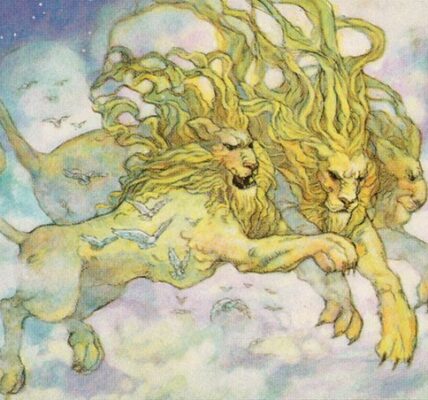As a big fan of Figure of Destiny from my early days of playing Magic the Gathering, I was quite excited to learn about Ascendant Spirit from Kaldheim. Both Figure of Destiny and its cousin Warden of the First Tree from Dragons of Tarkir were quite playable in Standard during their respective heydays. In some ways, Ascendant Spirit stands apart and may actually be more playable than its similar predecessors.
Both Figure of Destiny and Warden of the First Tree gave you the ability to dump mana into them in order to “evolve” them into bigger and better creatures. It’s similar to the Level Up mechanic from Rise of the Eldrazi, but without the keyword ability. Over the course of a game, the one-mana creature could rapidly grow into a massive flying or trampling threat.
Ascendant Spirit can do this, too, but with a couple of very important differences. First off, it’s a Snow creature. It also requires Snow mana to activate its abilities. Secondly, in the late game, Ascendant Spirit can become a serious source of card advantage.
One plus with Ascendant Spirit is that while the activated abilities have to be paid with mana from Snow sources, the color doesn’t matter. This makes it much easier to play in multi-color decks. Figure of Destiny needed either red or white mana, while Warden of the First Tree was a Green card, but needed White or Black mana to activate its abilities.
Let’s break down Ascendant Spirit’s abilities. It begins as a 1/1 vanilla Spirit, but things escalate quickly.
(Snow)(Snow): Ascendant Spirit becomes a Spirit Warrior with base power and toughness 2/3.
This is a bit less efficient than Figure of Destiny’s single-mana ability to become a 2/2 Kithkin Warrior, and Warden of the First Tree’s 3/3 Human Warrior for one generic and a Black or White mana. It’s still reasonable for a permanent buff, especially in Blue, though.
(Snow)(Snow)(Snow): If Ascendant Spirit is a Warrior, put a flying counter on it and it becomes a Spirit Warrior Angel with base power and toughness 4/4.
This second ability is better than Figure’s three mana ability to become a vanilla 4/4 and comparable to Warden’s four mana ability (two generic mana and {W/B}{W/B}) to gain trample and lifelink. Flying is obviously a big deal, as long as you don’t run into anything that can remove the flying counter – such as Heartless Act.
(Snow)(Snow)(Snow)(Snow): If Ascendant Spirit is an Angel, put two +1/+1 counters on it and it gains “Whenever this creature deals combat damage to a player, draw a card.”
The best part about this ability is that it’s repeatable. Not only can you pay four Snow mana to get two additional +1/+1 counters, but the ability to draw a card when it deals combat damage stacks. It’s not impossible for this to be drawing more than one card per turn in the late game. However, at the time of release, a spell card called Heartless Act could easily strip two of the plus one counters and the flying counter and make swinging with the Spirit rather awkward.
Figure of Destiny could become an 8/8 with flying and first strike for five mana if it was already a Spirit Warrior. While that’s better in some ways, it lacks the repeatable card advantage of the Spirit. The Warden had a similar ability to put five +1/+1 counters on it for 6 mana (three generic and {W/B}{W/B}{W/B}). That ability was also repeatable, and it can be argued that having the trample and lifelink makes it a superior threat.
Heartless Act aside, there was also Bloodchief’s Thirst to deal with the Spirit, as well as any other removal that destroys smaller creatures. Despite getting bigger, it remains a one-mana creature. However, that’s a benefit as much as it is a drawback. It’s a one-mana creature that’s still relevant in the late-game, especially if you’re in top-deck mode. Yes, the mana investment can be huge, but so can the payoff.
One deck that Ascendant Spirit immediately benefited was Mono-Blue Tempo decks in Historic on Magic Arena. It gave that deck a mana sink when it’s not playing bounce spells or counter spells. In Standard, Mono Blue Control lists were happy to run it and compete with a full playset in many different variants of the strategy.
Long term, Ascendant Spirit appeared destined to break into Spirit Tribal decks in Modern and Pioneer. Unfortunately for this one-drop Spirit, Modern decks couldn’t find room for it. However, Pioneer decks did find room. Almost as soon as it was printed, Pioneer Mono-Blue Spirit Aggro decks were very quick to adopt it. Meanwhile, Modern decks preferred to incorporate more White Spirits, leaving no room for our little Snowy friend.
The only real “downside” to playing Ascendant Spirit is the need for Snow mana sources. Fortunately, if you’re playing a mono-colored deck, throwing two or three copies of Faceless Haven into the list is easy enough. These days Pioneer Mono-Blue Spirits lists just run Snow-Covered Islands anyway, so the Havens not only power the Ascendant Spirits but their own creature land ability. Better yet, Faceless Haven is all creature types when it’s active, so it benefits from the Spirit type boosts!
With how pushed Snow was in Kaldheim, the availability of Snow Covered lands and the now underappreciated Faceless Haven made Ascendant Spirit a staple in the Pioneer Mono-Blue Spirits archetype. It’s a deck that’s alive and well in Pioneer, even if it’s not taking home tournaments on a regular basis. There’s nothing wrong with being part of a consistent Top 8 contender in a format that’s eclipsing Modern in popularity.
Far as Snow cards are concerned, the opportunity cost of playing this creature is quite low, as long as you’re dedicated to running Snow lands. It wasn’t even considered the best Snow creature in the set, but it’s certainly had the most staying power at top tournament tables.
What do you think of Ascendant Spirit?
DISCLAIMER: Portions of Obscure Curiosities Magic the Gathering related content are unofficial Fan Content permitted under the Wizards of the Coast Fan Content Policy. The literal and graphical information presented on this site about Magic: The Gathering, including card images, the mana symbols, and Oracle text, is copyright Wizards of the Coast, LLC, a subsidiary of Hasbro, Inc. The content on this website is not produced by, endorsed by, supported by, or affiliated with Wizards of the Coast.







